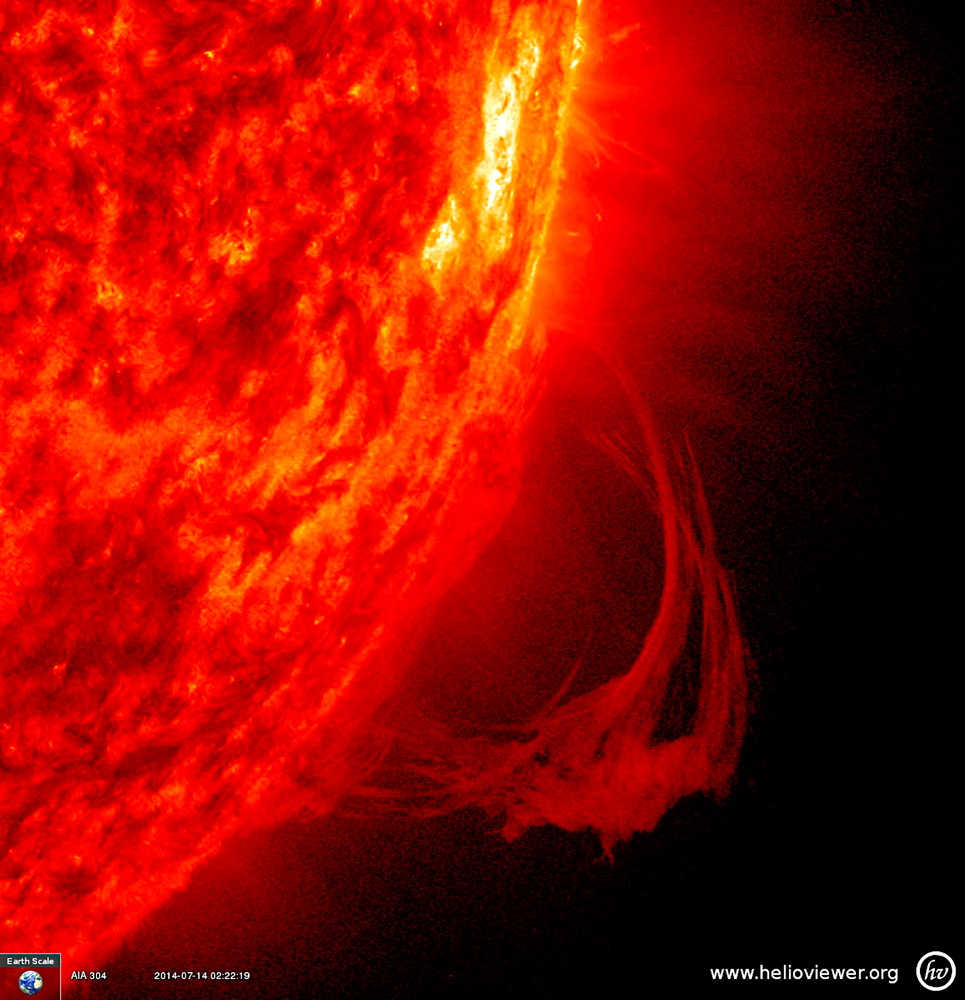Huge Solar Storm of 2012 Would Have Sparked Calamity on Earth
If a huge solar eruption in 2012 had hit the Earth, the effects would have been so devastating that we'd still be recovering two years later, scientists working on several new studies conclude.
A huge coronal mass ejection — a large cloud of hot plasma sent into space — erupted from the sun on July 23, 2012. The CME went through Earth's orbit, and had it happened only one week earlier, our planet would have been in the way and faced severe technological consequences.
There would have been three waves of damage associated with the extreme solar storm. First, X-rays and ultraviolet radiation from the solar flare would have produced radio blackouts and GPS navigation errors. The second part would have seen satellites fried by energetic particles like electrons and protons, which arrived only minutes to hours later. [Biggest Solar Flares of 2014: Sun Storm Photos]
Finally, magnetized plasma from the CME would have struck our planet within the next day. Power blackouts could have been devastating, making it difficult to even flush the toilet because most urban areas use electric water pumps.
"I have come away from our recent studies more convinced than ever that Earth and its inhabitants were incredibly fortunate that the 2012 eruption happened when it did," Daniel Baker at the University of Colorado, who led a study of the storm in Space Weather, said in a statement.
Disturbance in the solar force
Researchers know about severity of the space weather thanks to NASA's STEREO-A spacecraft, one of a twin NASA pair of satellites that is examining the sun. It found that the magnitude of the flare was similar to the Carrington event, an 1859 solar storm that set telegraph lines aflame as the Northern Lights were seen as far south as Cuba.
Breaking space news, the latest updates on rocket launches, skywatching events and more!
STEREO-A wasn't hurt by the blast because it travelled safely outside the Earth's magnetosphere, a zone above our planet that carries magnetic currents and can short out satellites. Also, the satellite was designed to withstand solar shocks — unlike some others.
"Thanks to STEREO-A we know a lot of about the magnetic structure of the CME, the kind of shock waves and energetic particles it produced, and perhaps most importantly of all, the number of CMEs that preceded it," Pete Riley of Predictive Science Inc., who published an unrelated paper in Space Weather, said in the same statement.
Riley calculated that in the next 10 years, there is a 12 percent chance that a Carrington-class solar storm could happen. He used a parameter called Dst, "disturbance – storm time," that looks at how much the magnetic field around Earth shakes when coronal mass ejections hit.
Astronomers today estimate the Dst for Carrington was anywhere between negative 800 nanoTesla (nT) and negative 1,750 nT. By comparison, an ordinary storm that causes northern and southern lights only produces about negative 50 nT.
In March 1989, the province of Quebec in Canada lost power due to an intense solar storm that was measured at negative 600 nT. The geomagnetic storm that narrow missed Earth in 2012 was twice as powerful, Riley said.
'Perfect solar storm'
The 2012 storm was so powerful that several coronal mass ejections erupted from the sun, creating a "superstorm" that made it many times more powerful than an ordinary one, an unrelated paper in Nature Communications said.
The blast was actually a "double-CME" — two CMEs separated by only 10 to 15 minutes — that whizzed through an area of space that had already been cleaned by another CME just four days before.
This meant the interplanetary medium in that region was not as thick as usual, the University of California, Berkeley's Janet Luhmann and former postdoctoral researcher Ying Liu found.
"It's likely that the Carrington event was also associated with multiple eruptions, and this may turn out to be a key requirement for extreme events," added Riley. "In fact, it seems that extreme events may require an ideal combination of a number of key features to produce the 'perfect solar storm."
Follow Elizabeth Howell @howellspace. Follow us @Spacedotcom, Facebookand Google+. Original article on Space.com.

Elizabeth Howell (she/her), Ph.D., was a staff writer in the spaceflight channel between 2022 and 2024 specializing in Canadian space news. She was contributing writer for Space.com for 10 years from 2012 to 2024. Elizabeth's reporting includes multiple exclusives with the White House, leading world coverage about a lost-and-found space tomato on the International Space Station, witnessing five human spaceflight launches on two continents, flying parabolic, working inside a spacesuit, and participating in a simulated Mars mission. Her latest book, "Why Am I Taller?" (ECW Press, 2022) is co-written with astronaut Dave Williams.



